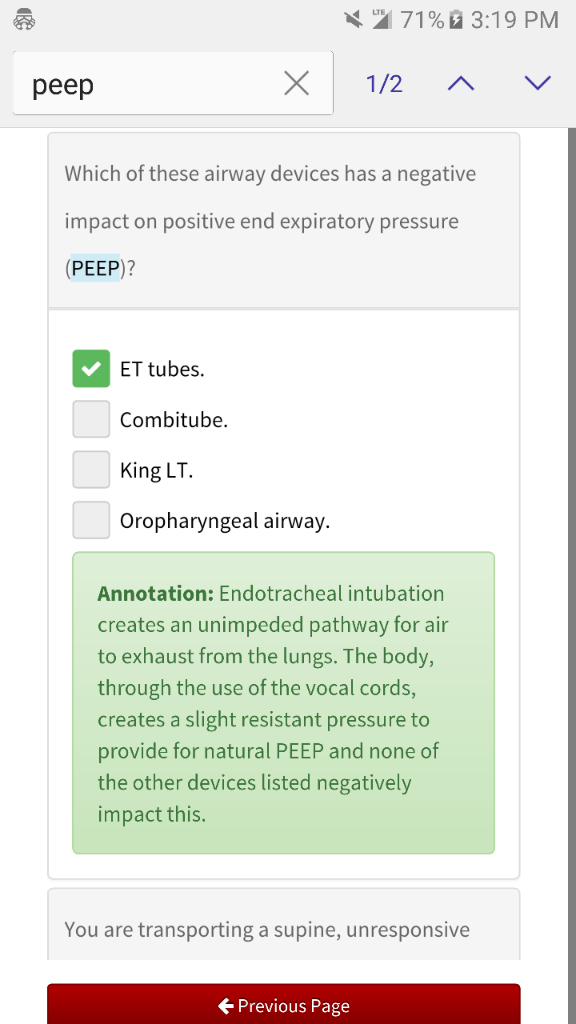gonefishing
Forum Deputy Chief
- 1,374
- 412
- 83
Anyone have any thoughts or input on this? LOL

Sent from my SM-G920P using Tapatalk

Sent from my SM-G920P using Tapatalk
Follow along with the video below to see how to install our site as a web app on your home screen.
Note: This feature may not be available in some browsers.

Ah, to PEEP or not to PEEP that is the question...
So we just sat through a weeks worth of in-service on our new ventilator, and in talking with the rep providing our in-service, it would appear that PEEP as a whole really isn't as harmful as once suspected. QUOTE]
I'd go so far as to say than no PEEP is harmful. In healthy lungs, I'm finding myself giving 8 of PEEP as a matter of routine, or as directed by measured by auto-peep if I have the capability with diseased lungs.
I wouldn't say no PEEP is harmful. Certainly in someone with healthy lungs, it's pretty hard to hurt them. But generally speaking, the lowest pressure you can use and keep full recruitment, the better.
I think the idea of atelectrauma from alveolar instability over the respiratory cycle is behind the strategies of avoiding ventilator induced lung injury. Without PEEP, when the atelectasis occurs, the alveoli "pop" open causing shear stress and inflammation. Over time it causes lung injury.
Thank you so much for your input!Little misunderstanding here.
A few posts up someone said "I'd go so far as to say that no PEEP is harmful". Because that statement was followed up with "I use 8 of PEEP as a matter of routine", I thought what was meant by "no PEEP is harmful" was "even very high levels of PEEP are not harmful", rather than "PEEP of 0 is harmful".
So when I wrote "I wouldn't say no PEEP is harmful", what I meant was "I wouldn't say that unnecessarily high levels of PEEP can't contribute to harm".
My bad.
ARDSnet does call for starting at a PEEP of 5 and basically only increasing it as necessary,- just like fi02 - with the reasoning being that mean airway pressure should ideally be kept as low. The only time I use more than 5 in the OR is if they need it because their lungs are bad, or during laparoscopic cases when the abdomen is insufflated, especially when they are obese, and especially when they are in a head-down position, and in those cases I generally start at 8. But of course I've used much higher than that, both in anesthesia and during transport.
Regarding the icon in the upper left-hand corner, I also play StarWars commander. Looks like "Your troops are ready commander."Anyone have any thoughts or input on this? LOL

Sent from my SM-G920P using Tapatalk
LOL!!!!!!!!Regarding the icon in the upper left-hand corner, I also play StarWars commander. Looks like "Your troops are ready commander."
I don't know if it's current trends or not, but what I was referring to was the increases in PEEP patients are being left at depending on their condition, and the fact that they're finding that these increases---even if sustained---don't necessarily produce the level of volutrauma or barotrauma which once suspected, prevented such patients from receiving higher PEEP parameters in order to improve oxygenation.
https://www.ncbi.nlm.nih.gov/m/pubmed/23740697/
Yes, our current ventilator protocols dictate managing patients based on their condition, whether suspected or confirmedOne of the problems with teasing out issues like "low" tidal volumes and varying PEEP is how these things are defined in various studies. They differ quite a bit from study to study. Consensus (for what it's worth) seems to be "some PEEP" and peak pressures less than 30 to avoid VILI, most of which comes from the ARDS net protocols. But those protocols are for folks with lung injury, so applying that to patients that don't is sort of up for grabs. So for me, 7 ml per kg PBW and 8 of PEEP and .4-.6 fiO2 is my routine for "healthy" patients.
